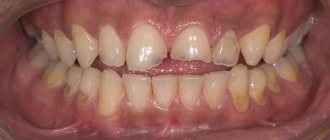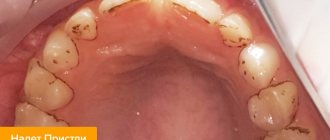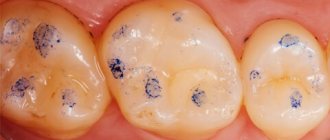Unfortunately, our teeth are at risk of various types of damage every day. And first of all, the enamel of the teeth takes the blow. Today, the work of dental clinic specialists is aimed not only at preserving enamel (professional teeth cleaning, treating the first rudiments of caries, removing plaque and tartar), but also at restoring it.
Dental tissue, consisting of calcium, magnesium and phosphorus, is formed due to mineral metabolism. It is these elements that contribute to its strength. Disruption of mineral metabolism (demineralization) leads to gradual tooth destruction: under the influence of unfavorable factors, the crystalline structures of the teeth weaken. Tooth enamel becomes less durable, and it becomes increasingly difficult for it to fight harmful bacteria. The result is the development of caries.
How does remineralization occur?
Every day our body is exposed to the negative effects of various factors. The process of weakening enamel can be started due to poor nutrition, poor drinking water, regular overexertion and a general lack of organic substances.
When pathogenic flora begins to develop in the oral cavity, the mechanism of natural remineralization of teeth, which works continuously under normal conditions, is disrupted; the leaching of mineral elements begins. The process is called “demineralization,” and if it is not stopped, carious disease and a number of other pathologies can develop.
Remineralization of tooth enamel is the opposite of demineralization. Remineralization can be achieved through restorative procedures that will restore strength to dental tissue and increase its resistance to pathogenic bacteria. There are several recovery options:
- Natural remineralization of teeth: replenishing the balance of biologically significant elements through the consumption of foods high in calcium and fluoride, and additional oral hygiene procedures.
- Artificial remineralization: saturation of enamel using remineralizing drugs. It is carried out both in the dental office and at home.
Detection methods
Visual inspection
After cleaning the plaque, the teeth are isolated from saliva and dried. The dentist notes demineralization in the presence of white matte spots with a rough surface. Most often, pigmentation is localized in the cervical region (at the gingival margin).
Vital staining of enamel (Borovsky-Aksamit test)
A swab soaked in a two percent solution of methylene blue is applied to the cleaned and dried teeth for three minutes. As a result, the demineralized areas become stained. The brighter the shade of blue, the deeper the damage to the enamel.
Ultraviolet research
Under ultraviolet rays, the affected areas glow darkly. They contrast with healthy enamel, illuminated blue. Such diagnostics can be carried out using the Pluraflex device.
Laser examination
The DiangoDENT device is used. Mineral-deficient enamel reflects laser waves above 680 nm, and the device emits a characteristic signal.
Who is the procedure indicated for?
Remineralization and fluoridation of teeth is prescribed for the following problems:
- sensitive reaction of enamel to temperature differences
- pathological abrasion of teeth
- recovery after orthodontic treatment
- impaired metabolism in the body
- mineral deficiency during pregnancy, menopause or puberty
- weakened enamel after professional whitening
Who should not undergo the procedure: people intolerant to remineralizing drugs, as well as those who have kidney disease and problems with the pancreas.
Signs of demineralization
The lack of minerals appears gradually. At first, the crowns simply become matte. The beautiful pearly shine that characterizes a healthy smile disappears.
Then more noticeable defects are added:
- the enamel becomes rough;
- white chalky spots appear;
- light spots darken and turn brown;
- the enamel takes on a “porous” appearance.
All this “beauty” most often appears between the teeth - on the side surfaces of the crowns, at the edge of the gums, on the fissures - the chewing grooves of the tooth. To see the first signs of demineralization, just look at your smile in the mirror. And it would be better to notice the problem right away, because at the stage of brown spots, others will notice it.
Demineralized tooth in section
Remineralization of tooth enamel as professional hygiene
Professional remineralization can be carried out using various means:
Fluoride varnish
The teeth are coated with a concentrated fluoride composition, which saturates the hard tissues and helps resist carious bacteria.
Artificial enamel
Also serves to coat teeth to prevent problems with natural enamel. But if the hard tissue has already undergone negative changes, this method will not help get rid of the consequences, so it is advisable to resort to it in order to prevent the disease in the future.
Electrophoresis
One of the most popular and effective methods of deep remineralization of teeth. The procedure consists of electrotherapy with the introduction of remineralizing substances.
Prevention is the key to success
To maintain the remineralization effect, careful oral care is necessary.
Brush your teeth 2 times a day with a special toothpaste to strengthen the enamel. After eating, rinse your mouth with solutions that strengthen enamel and gums. Use floss and irrigator to remove food debris from between teeth. In addition to a balanced diet, we also recommend drinking at least 1.5 liters of water per day, limiting smoking and drinking strong coffee. The best way to keep your teeth healthy is through regular dental checkups and professional oral hygiene at least twice a year.
This will allow timely identification of the problem and mineralization of the teeth. If you experience the first symptoms of demineralization, contact the specialists of the DomodenT clinic. After a thorough examination, we will make an accurate diagnosis and provide effective treatment. Our doctors will take care of your teeth and the beauty of your smile.
Commenting system SigComments
Back to section
Remineralization of teeth at home
You can solve the problem of thinning enamel not only in the dental office, but also on your own. For this purpose, there are various lines of drugs for remineralization of teeth. It makes sense to carry out such activities without professional help only if there is no visible damage to the dental tissue.
Important!
It is optimal to remineralize teeth at home with two different pastes with fluoride and calcium. It is recommended to brush your teeth first in the morning, and the second before bed. Make sure that one product does not contain both components, since together they create a stable connection and become useless.
In order for teeth remineralization to bring the best results, you must first brush your teeth thoroughly. This will allow the drug to most effectively contact the surface of the teeth.
One of the popular methods of saturating tooth enamel at home is remineralizing teeth with salt. To do this, it is best to use sea salt powder mixed with a few drops of vegetable oil to form a paste. The resulting mass should be rubbed in in the morning and at the end of the day after the teeth have been brushed.
You can also try gum massage at home. The attending physician will tell you what kind of massage promotes the remineralization of hard dental tissues.
A properly formulated diet will help maintain a healthy balance of minerals. The more you consume foods containing calcium, fluoride and phosphorus, the lower the risk of enamel destruction. These include:
- milk, sour cream, cream, cottage cheese;
- meat products;
- cabbage, spinach, zucchini and other green vegetables;
- almonds and sesame;
- soybeans, beans, chickpeas, peas.
It is recommended to add vitamins and minerals from time to time, but it is better to ask your dentist or therapist about your specific choice.
Focal demineralization of enamel in children
Focal demineralization of teeth is the initial degree of caries, in which spots appear not only in the cervical area, but also on the chewing surface - fissures. Usually, 1 month of excessive consumption of sucrose in conditions of poor hygiene is enough for focal demineralization to make itself felt.
The pathology most often affects children aged 9–11 years – from 15 to 40% of the child population, depending on the region of residence. Sweets, crackers and chips contribute to this - carbohydrates that provide food for bacteria. In addition, not every child follows all the rules of oral hygiene.
Focal demineralization in children
Means for remineralization of teeth
For modern remineralization of teeth at home, there are many effective means that can be used not only for prevention, but also for treatment.
Pastes:
JASON Sea Fresh with fluoride is a gel paste with therapeutic and prophylactic effects. Fluoride and various plant extracts protect against pathogenic bacteria and enrich the enamel.
Biorepair Total Protection Plus is an antibacterial paste, especially suitable for those who have just undergone orthodontic treatment with braces. The product is hypoallergenic. For even more effective remineralization of tooth enamel, you can supplement it with Biorepair Night Repair paste, which restores enamel overnight.
Theodent Classic - unlike other brands of toothpastes, this is the only one that contains the unique patented element theobromine. The properties of theobromine contribute not only to the restoration, but also to the production of enamel. This is the best option for caries prevention.
Twin Lotus SENSITIVITY - a paste recommended for people with increased sensitivity of teeth, as it effectively reduces pain due to aloe and acmella in the composition and strengthens the enamel.
Miradent® Mirasensitive hap+ - reduces sensitivity, while the potassium ions in the composition provide protection right down to the nerve of the tooth.
Gels:
GLOBAL WHITE is a remineralizing gel from a famous American brand. Effectively reduces the sensitivity threshold and restores weakened enamel.
Miradent® gel is an intensive protective agent for the remineralization of teeth with fluoride, recommended for the prevention of caries.
For convenient use of gels, you can purchase special trays for Diamondbrite remineralizing applications.
Mousses and foams:
GC Tooth Mousse is a mousse for the remineralization of hard dental tissues, helps reduce sensitivity, prevent plaque formation and neutralize acidity in the oral cavity. Not suitable for people with allergies to milk proteins.
Professor Persin is a restorative foam for those who do not always have the opportunity to brush their teeth. Helps reduce sensitivity, strengthen enamel and generally have a beneficial effect on oral health.
Rinse aids:
4-action BioRepair is a remineralizing rinse for people with hypersensitive teeth. Thanks to the active Microrepair® particles in the composition, it restores enamel even in the most difficult to reach places, prevents the formation of tartar and the development of caries.
The listed means of teeth remineralization can be used either independently or in addition to professional treatment. You should consult with a specialist regarding the choice of specific products for better remineralization of teeth.
Development forecast
Under conditions of proper nutrition and corrected hygiene, in 20-30% of patients, the destruction of enamel stops spontaneously, and the enamel is restored naturally.
In other cases, the loss of minerals leads to the development of caries: the lesion begins to progress from the stage of focal demineralization. On average, 12-18 months pass from the very beginning of the process until the appearance of a carious cavity.
With timely treatment, caries may not develop, teeth can be kept intact and healthy.
Focal loss of minerals is the only reversible stage of caries.











